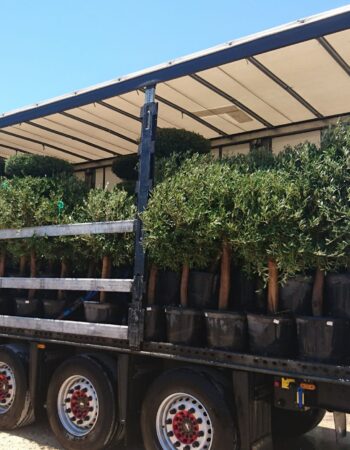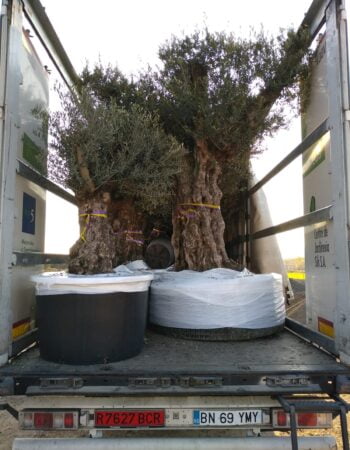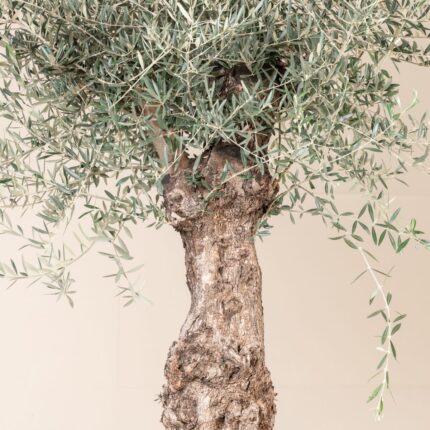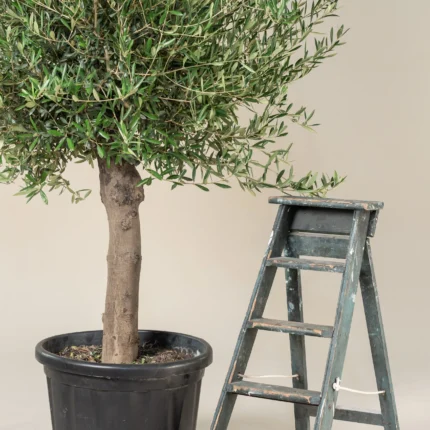Chamaerops Excelsa
Chamaerops excelsa, also known as the Giant Fan Palm, is a robust and striking palm native to the Mediterranean region. Unlike its smaller relative, Chamaerops humilis, the Giant Fan Palm grows with a single trunk, which is often covered in fibrous leaf bases and has a more imposing presence. The palm adds a dramatic touch to landscapes with its lush, broad fronds and towering stature.
- Botanical Name: Chamaerops excelsa
- Common Name: Giant Fan Palm
- Mature Height: 20-30 feet (6-9 meters)
- Mature Spread: 15-20 feet (3-6 meters)
- Growth Rate: Slow to moderate
- Light Requirements: Full sun to partial shade
- Soil Requirements: Well-draining soil; prefers sandy or loamy soils but tolerates a range of soil types
- Water Needs: Low to moderate; drought-tolerant once established
- Foliage: Evergreen, with large, fan-shaped fronds that are green to blue-green
- Flowers: Small, yellowish flowers in inconspicuous clusters, typically appearing in summer
- Fruit: Small, brown to black, round fruits that are not particularly ornamental
Uses:
- Ornamental Palm: Ideal for creating a dramatic focal point in large gardens and landscapes.
- Landscape Design: Can be used as a specimen plant, in groupings, or as part of tropical-themed gardens.
- Shade Tree: Provides substantial shade with its large, spreading fronds.
- Coastal Landscaping: Well-suited for coastal areas due to its salt tolerance and robust growth.
Benefits:
- Dramatic Appearance: Features large, impressive fronds and a tall stature that create a striking visual impact in the landscape.
- Drought Tolerance: Adapted to dry conditions, making it a low-maintenance choice for water-wise gardens.
- Low Maintenance: Requires minimal care once established, with occasional pruning and minimal pest and disease issues.
- Versatile Use: Suitable for a variety of garden settings, including large landscapes, coastal areas, and tropical-themed gardens.
Chamaerops excelsa (Giant Fan Palm) is a majestic and versatile palm that enhances gardens and landscapes with its grand presence and distinctive foliage. Its adaptability, drought tolerance, and low maintenance requirements make it a valuable addition to large outdoor spaces.
Debes acceder para publicar una valoración.


CAREFUL TREE TRANSPORTATION
At Treezom, we take great care in transporting your trees to ensure they arrive in perfect condition. Our expert team uses various methods, depending on the size and volume of the order, to provide safe and efficient delivery. Whether you're ordering a single tree or a bulk order, we guarantee high standards of handling and care throughout the process.
MULTIPLE SHIPPING METHODS
- Truck Delivery: Ideal for local or regional deliveries, ensuring a smooth and timely shipment of your trees directly to your location.
- Sea Containers (20’ or 40’): Perfect for larger orders or international shipping. Our sea containers are equipped to handle bulk shipments with optimal protection.
- Other Customized Solutions: Depending on the size and nature of your order, we can offer tailored shipping methods to meet your specific needs.
No matter the shipping method, we use specialized packaging and handling procedures to protect the trees during transit, ensuring they arrive healthy and ready for planting.
Below, you’ll find key tips tailored to this species’ requirements. Whether you’re new to plant care or have plenty of experience, these guidelines are here to support you in keeping your green companion healthy and vibrant.
- Planting:
- Choose a location with full sun to partial shade and well-draining soil.
- Dig a hole twice the width of the root ball and equal in depth.
- Place the plant in the hole, backfill with soil, and water thoroughly.
- Ensure adequate space from other plants and structures to accommodate the palm's large size.
- Watering:
- Water regularly during the establishment period to support healthy root development.
- Once established, Chamaerops excelsa is drought-tolerant and requires minimal watering.
- Allow the soil to dry out between waterings, and avoid overwatering to prevent root rot.
- Pruning:
- Remove dead or damaged fronds as needed to maintain a tidy appearance and promote healthy growth.
- Prune in late winter or early spring before new growth begins.
- Avoid heavy pruning, as this can stress the palm and reduce its ornamental value.
- Fertilizing:
- Feed with a balanced, slow-release fertilizer in early spring to support robust growth.
- Avoid excessive fertilization, which can lead to excessive foliage growth and reduced plant health.
- Reduce fertilization in the winter months or during periods of dormancy.
- Pest and Disease Control:
- Chamaerops excelsa is relatively pest-resistant but can occasionally suffer from pests such as spider mites, scale insects, and mealybugs; treat with insecticidal soap or horticultural oil if necessary.
- Monitor for fungal diseases like leaf spot and root rot; ensure good air circulation and avoid waterlogged soil.
- Regularly inspect the palm for signs of pests or disease and address issues promptly.
*This information is provided for informational purposes only. For more detailed care, please consult a professional Gardener or Arborist.
Send a support message to the vendor below:


 SINGLE TREE
SINGLE TREE OUTDOOR POTS
OUTDOOR POTS




















 Single Tree
Single Tree
Valoraciones
No hay valoraciones aún.